As an Amazon Affiliate, I earn from qualifying purchases at no extra cost to you.
This Free Rhinoceros Unit Study has all you need to learn about Rhinos with your students in a fun way with videos, crafts, printables and even an interactive quiz!
The most enjoyable way to learn about something is to explore it from every angle and in every way possible. With this Rhinoceros Unit Study, your children AND you will enjoy learning about Rhinos as you watch videos, read books and do crafts and printables. Have fun!
In the printables section there is no end to keep everyone busy; find word scrambles, word searches, I spy, how many words can you find, coloring pages and a crossword puzzle!
There are also educational videos to watch, new books to check out, jokes to enjoy together and songs to learn.
Maybe you want to learn about Rhinos for a school project, for World Rhino Day, Save the Rhino Day or just because you enjoy the amazing creatures. For whatever reason, this post will make it easy!
Follow my Rhinoceros Pinterest Board for dozens of ideas from all around the web! I am constantly finding new things to add so there will be new things all the time!
When is National Rhino Day?
World Rhino Day is September 22nd and Save the Rhino Day is May 1st.
This Unit Study is the perfect thing to do leading up to that day. Of course, any time is a great time to learn about rhinos.
Other Unit Studies
Seasons and Holidays
Animals
Facts about the Rhinoceros
First, the plural of rhinoceros is rhinoceros. Or rhinoceroses. Or even rhinoceri. If you are unsure, you could just be safe and use rhinos. They are all correct. Rhinoceros is the most common plural of the full name.

Rhinos are the second largest land mammal.
They live in grassy plains, rainforests and swamps of Africa, Indonesia and India.
The average lifespan of a rhino is 40-50 years.
Their name rhinoceros means “nose horn”.
The rhino horn is made up of keratin, the same as our hair and nails.
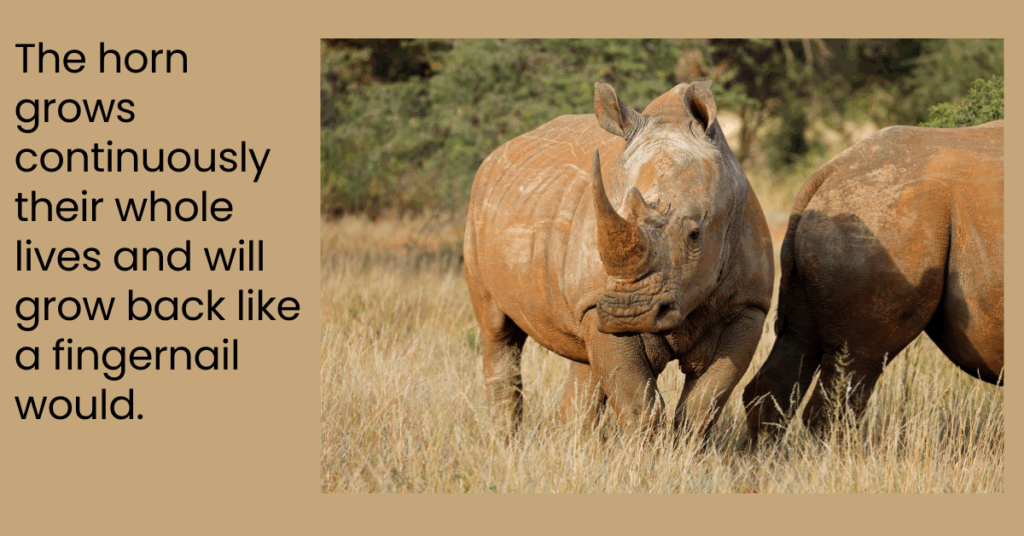
The horn grows continuously their whole lives and will grow back like a fingernail would.
The white rhino’s horns can grow 2-3 inches every year! The record length is 59 inches! That is almost 5 feet long!
A rhino will rub their horn on rough surfaces to keep it sharp. It is a weapon to defend themselves for the white or black rhino. The Asian species will use their tusks; their razor sharp incisor teeth that can grow up to 5 inches long.
Rhinos have 3 toes on each foot. They also have thick, padded soles so they can walk and run on rough surfaces.
Male rhinoceros are called bulls, female rhinoceroses are called cows and their young are called calves.
Cows are pregnant for 15 months before their calves are born.
Rhino calves weigh 130-260 pounds when they are born. Different species weigh a different amount.
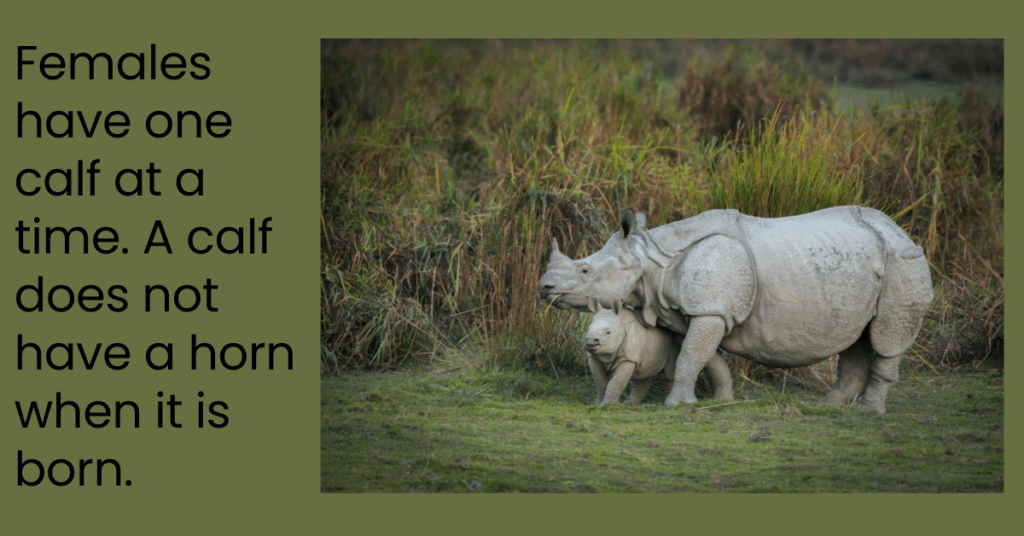
Females have one calf at a time. A calf does not have a horn when it is born.
Rhinos are mammals so calves drink milk from their mothers.
Calves stay with their mothers for 2 to 3 years.
Most rhinos are solitary, especially males.
White Rhinos are the most social species and some of the females may live in a group of up to 10 rhinos.
A group of rhinos is called a crash.
A crash is usually made up of a female and her babies or several females.
Rhinos make a lot of different sounds that mean different things. They can grunt, snort, squeak, bellow, growl and more. Take a listen to this video that shows you many different sounds.
Rhinos are herbivores. They eat fruits, vegetables, grass, leaves, twigs and plants. None of them eat meat of any kind and the exact types of plants depend on what kind of mouth they have and exactly where they live.
They have a very good sense of smell and hearing but do not see well.
The rhinoceros ears move independently of each other to pick up and detect sounds.
Rhinos are not mean but they will attack if they get scared. Their instinct is to charge and because they can’t see well, they may charge a tree or a rock.
They sleep about 8 hours every day.
Rhinos can run up to 35 miles per hour.
White rhinos can make as much as 50 pounds of dung (poo) a day! They use it to let other rhinos know where their territory is. Each rhino’s dung smells different. It is a way to communicate!
A rhino’s skin is up to 2 inches thick. It protects them from thorns and sharp grasses.
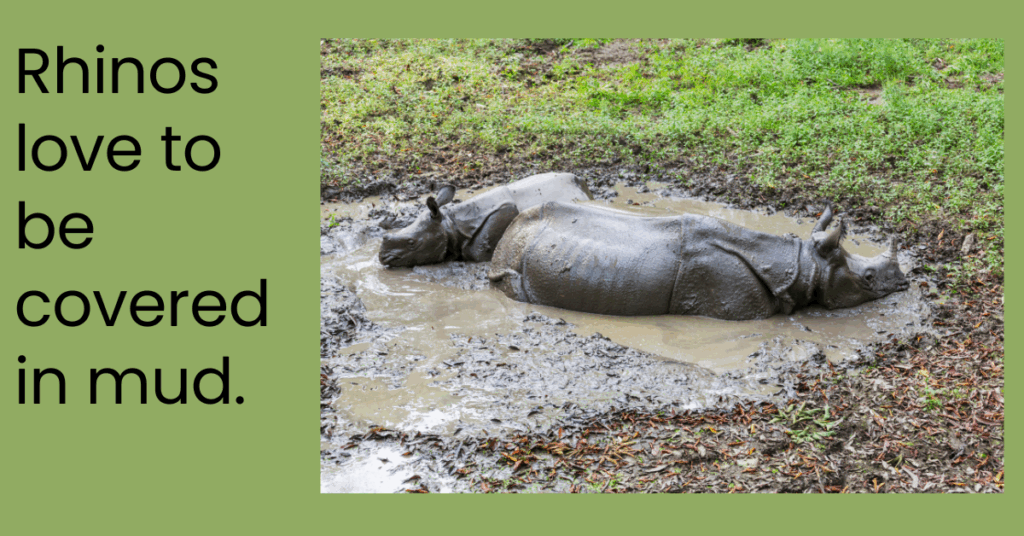
Rhinos love to be covered in mud. It protects them from the sun and biting insects. They can’t go to Walmart to buy sunscreen or insect repellent so covering themselves in mud is what works for them!
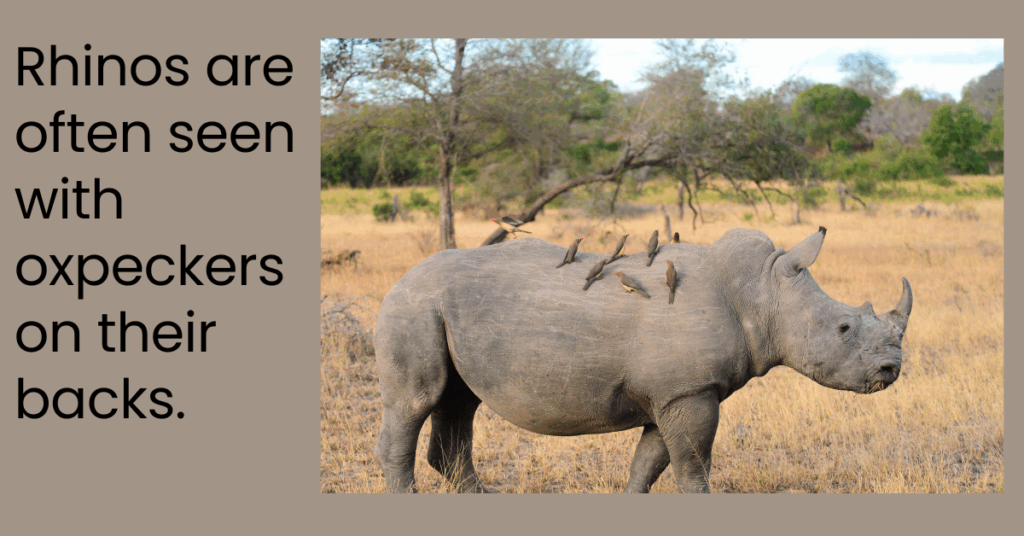
Rhinos are often seen with oxpeckers on their backs. These are birds that eat bugs off of their skin and they also warn them of possible danger. The birds get to eat the bugs so both the birds and the rhinos benefit from each other. This is called a symbiotic relationship. See an oxpecker and a rhino.
Adult rhinos have no natural predators but lions, tigers, leopards, crocodiles, wild dogs or hyenas may try to kill a calf.
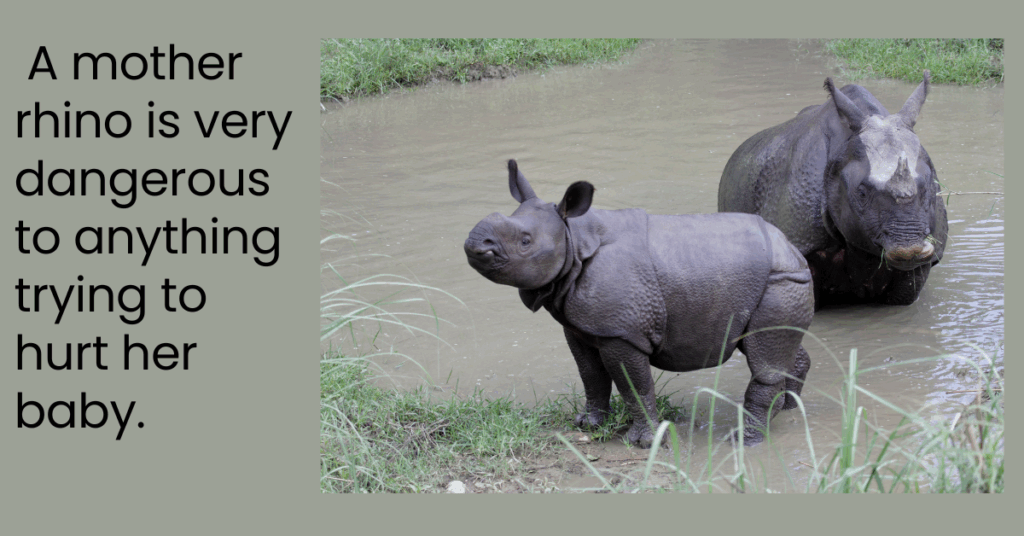
A mother rhino is very dangerous to anything trying to hurt her baby.
Two rhinoceros species are white rhinos and black rhinos but they are neither white nor black. They are both gray.
There are 5 species of rhinos.
Some have one horn and some have two horns.
Some live in Africa, some in Indonesia and some in Asia.
Some have a wide, flat upper lip and some have a pointed, prehensile upper lip. The wide mouth is used for grazing and eating grass and the prehensile lip is used for grasping leaves and twigs to eat.
Let’s see some characteristics of each species.
The 5 species of Rhinos
White Rhino
Lives in Africa
White Rhinos are largest rhino.
They can weigh over 7,000 pounds.
Males and females have 2 horns.
White rhinos have a wide, square lip.
They eat mostly grass.
Adults average 6-6.5 feet tall at the shoulder and 11-15 feet long. Males are about 5,000 pounds and females are about 4,000 pounds.
They are near threatened.
Black Rhino
Lives in Africa
Males and females have 2 horns.
Black rhinos have a pointed, prehensile upper lip.
They eat leaves from bushes and trees.
Adults average 5-6 feet tall at the shoulder and 11-13 feet long. Males are about 3,500 pounds and females are about 1,800 pounds.
They are critically endangered.
Sumatran Rhino
Lives in Indonesia
The smallest rhino
Males and females have 2 horns.
Has the most hair of all the rhinoceros species.
They have a prehensile upper lip.
The most threatened rhinoceros
Adults average 4 feet, 3 inches high at the shoulder, a length of 8-10.5 feet and weighs about 1,500 pounds.
Plantations for palm oil have destroyed much of the habitation of the Sumatran rhino.
They are vulnerable.
Javan Rhino
Lives in Indonesia
Males have 1 horn. The females have only small bumps 1-2 inches long.
They have a prehensile upper lip.
Adults average 5-5.5 feet high at the shoulder, a length of 10 feet and weighs 3,000-4,400 pounds.
They are critically endangered.
Greater One-horned or Indian Rhinos
Lives in India
Males and females have 1 horn.
Indian rhinos have a wide, square lip.
They use their teeth for defense instead of their horn.
Adult males average about 5,500-7,100 pounds and females average 4,200 pounds. They are 5.5-6.5 feet high at the shoulder and a length of 9.5-13 feet long.
They are excellent swimmers. Not all rhinos can swim but Indian rhinos can swim very well.
They are critically endangered.
Rhinos are in trouble!
Rhinos have no major predators but are still in danger of becoming extinct. Only the White Rhino is not in critical danger because of humans.
Rhinoceros horns are used in Asian medicine and for dagger handles in Northern Africa and China. Even though it has been proven that there is no value in medicine from them, they are still killed for their horns because people will pay a lot of money for them. And even though their horns could be taken without killing them, they are still killed.
Humans are also taking their habitat so they don’t have as much land for their homes.
Things we can do to help Rhinos.
There are people who are helping rhinos by protecting their habitats and also protecting the rhinos. Some will carefully cut off the rhino’s horns so they won’t be killed and have their horns taken. It is helping and their population is slowly growing!
We can help by learning as much as we can about them.
Videos about Rhinoceros
All About Rhinos for Kids: Rhinoceros for Children – FreeSchool 4:40
Save the Rhinos! | Animal Science for Kids 3:19
RHINOS FOR KIDS – Rhino Facts for Children, Kindergarten and Preschoolers by Kiddopedia 5:08
Rhinoceros Facts by Wildlife Chrystal 9:50 (Contains lots of good facts and also a bit about how kids can start a campaign to help them and a short quiz.)
Songs
The Rhino Song, Fun Evidenced Based Learning by Big Word Club 2:23 (Cute with some rhino facts)
Ballerino Rhinoceros | Rhinoceros | Animal Songs | Pinkfong Songs for Children 1:39 (cartoons mixed with real videos and song with facts)
Animal Rhymes for Kids – Rhinoceros song 1:44 (facts with a “speaking song” and words to follow along)
“Rhino Song” | Kids Songs | Kids Cartoons | Educational Animal Song | Have Fun & Learn 2:29 (song while showing video and words to follow along; also has a short quiz at the end)
Books
As an Amazon Associate, I earn from qualifying purchases at no extra cost to you.
 Buy Now →
Buy Now → 
National Geographic Kids Chapters: Rhino Rescue
Buy Now →
Rhinos: Horned Beast of the African Grasslands
Buy Now →
Rhinos!: A My Incredible World Picture Book
Buy Now →
Rhino: Wildlife Books for Kids
Buy Now →
Rhinos: The Ultimate Rhino Book for Kids
Buy Now →
Rhinoceros: Animals That Make a Difference!
Buy Now → Buy Now →
Buy Now → Some Jokes
Kids love jokes so I had to include some good ones here for them!
Printables
2 Rhino How Many Words Printables
2 Rhino Word Scramble Printables
2 Rhino Word Search Printables
My Little Book about the Rhinoceros
Crafts
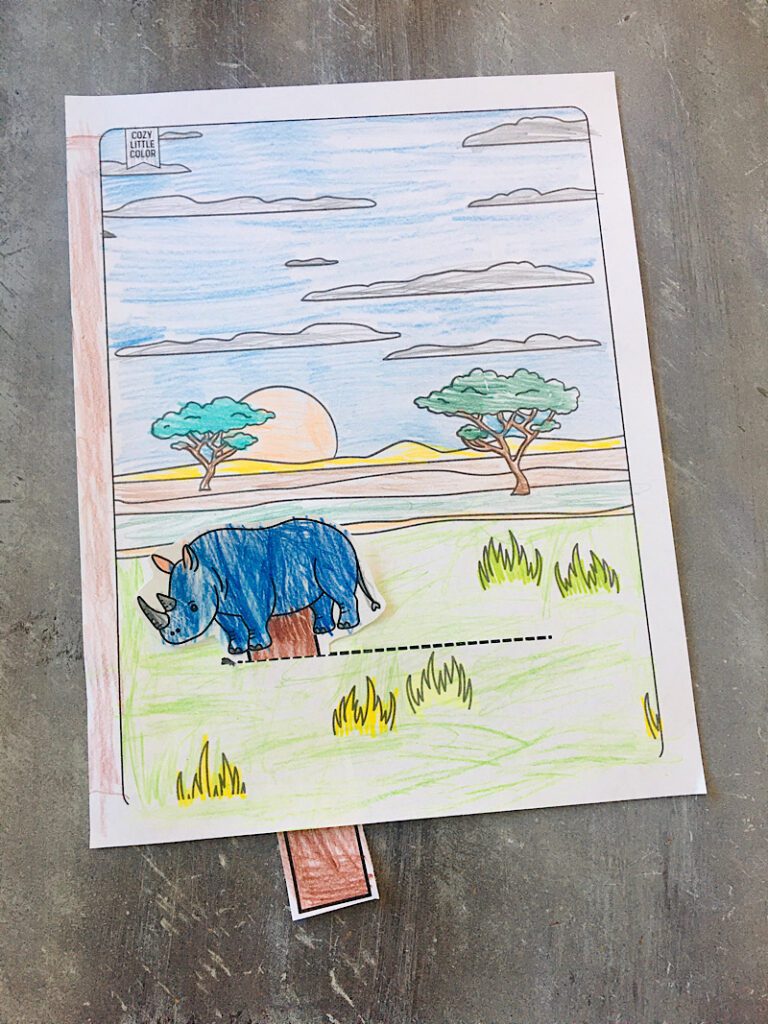
How to Draw Rhinoceroses
Here is some instruction on how to draw rhinos. They are all a little bit different and the outcome of what the rhinoceros looks like is a bit different so you can choose which you like.
How To Draw A Cartoon Rhino by Art for Kids Hub 6:27 on YouTube
How to Draw a Rhino by Art Land 9:55 on YouTube; step by step Very realistic
How to Draw a Rhino by Easy Drawing Guides (This is very realistic and has both video and step by step in the post.)
I found the facts for this post from the following sources
It is always good to cite your sources and if you would like to read more details, there is much more information at the links.
Rhinoceros from kids kiddle
Rhino from facts for kids
Rhino facts for kids from kidz feed
Now test what you learned with our Rhinoceros Quiz!
Rhino Interactive Quiz
As an Amazon Associate, I earn from qualifying purchases at no extra cost to you.

Rhino Stuffed Animal 12 inches
Buy Now → Buy Now →
Buy Now →  Buy Now →
Buy Now →  Buy Now →
Buy Now →  Buy Now →
Buy Now →  Buy Now →
Buy Now → If you make it, play it or use it, let me know! Rate it and leave a comment below. I love hearing from you!
Be Sure to Pin so you can find it easily later!
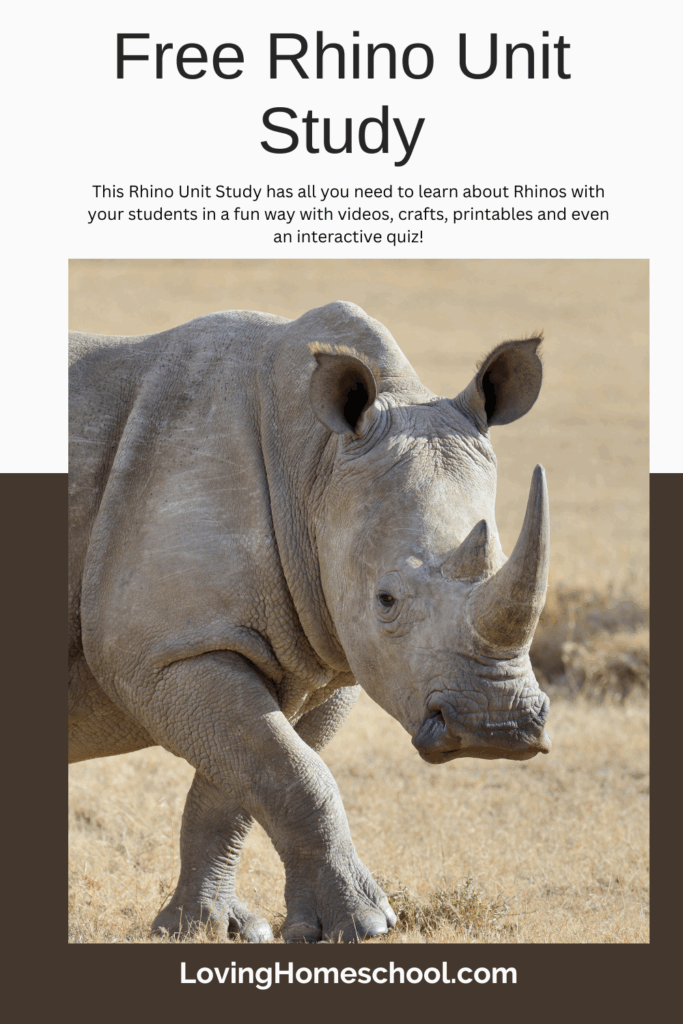
Are you following me on Pinterest? I have been working very hard making new boards I think you will love and am adding dozens of new pins from all of the popular homeschooling websites!
Come join us on our Facebook group, Loving Homeschool. I am adding daily pictures, links and much more than I would on the blogs and it is a place for you to find support from others on the same journey as you are. Come and share with others, ask questions and learn! And if you love recipes, follow my Best Recipes You Will Want To Make group on Facebook! Feel free to share your own favorites and find many new ones there!
I enjoy offering free printables and resources to bless my readers. Your frequent visits to my blog and purchases through affiliate links and ads keep the lights on so to speak. Thank you!

Cindy
Welcome! I am a wife, mother, mother-in-law, Grammy, daughter, sister and retired homeschooler. I enjoy writing about things I have learned over the years, sharing recipes and tips with others and making free printables for parents and teachers.











